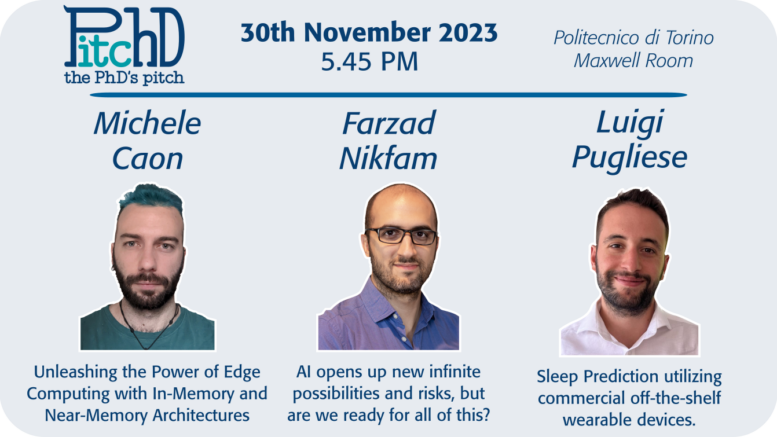30th November 2023 – 5.45 PM
Politecnico di Torino – Maxwell Room
Here’s the 5th PitchD – the PhD’s pitch. Our PhD IEEE Student Members explain to students, colleagues and professors their research in-presence. Please, remember that registration is required to attend the event.
Unleashing the Power of Edge Computing with In-Memory and Near-Memory Architectures
Mr. Michele Caon
Dept. of Electronics and Telecommunications (DET), Politecnico di Torino
Biography: Michele Caon is a PhD student in Electrical, Electronics, and Telecommunications Engineering at VLSI Lab in Politecnico di Torino under the supervision of Prof. Maurizio Martina and Guido Masera. He received his B.Eng. and M.Eng. (summa cum laude) at Politecnico di Torino in 2017 and 2019. His research interests are programmable embedded systems for energy-efficient edge computing. He is currently working on near-memory computing circuits integrated into open-source systems-on-chip.
Abstract: The widespread adoption of data-driven algorithms, such as artificial neural networks, across diverse applications has exposed the inherent limitations of traditional Von Neumann computing systems regarding performance and energy efficiency. This is especially evident for edge devices that are required to handle large amounts of online-acquired data while operating under stringent power and energy constraints. Heterogeneous systems emerge as ideal candidates to address these challenges in the near future, offering the flexibility of general-purpose CPUs together with the processing power and higher energy efficiency of application-specific subsystems. However, integrating multiple processing units on a single chip introduces challenges concerning memory bandwidth, data movement, and software overhead. Moving computation closer to the memory emerges as a promising solution to reduce data movement and instruction overhead, offering significant throughput and energy efficiency gains with limited hardware cost. This keynote will introduce the basic concepts and advantages of in-memory and near-memory architectures and discuss the trade-offs between them in terms of physical implementation, scalability, and flexibility. We will see how microcontroller systems can be seamlessly extended with such circuits and how to use them from a software perspective, highlighting the potential to revolutionize the deployment of computationally expensive applications on next-generation edge devices.
AI opens up new infinite possibilities and risks, but are we ready for all of this?
Mr. Farzad Nikfam
Dept. of Automation and Control Engineering (DAUIN), Politecnico di Torino
Biography: Farzad Nikfam received the Bachelor’s degree in Mechanical Engineering, in March 2018, and the Master’s degree in Mechatronic Engineering, in March 2020 from Politecnico di Torino, Turin, Italy. Now he is pursuing a PhD in Electronics and Communication Engineering at Politecnico di Torino and his research activity is focused on software machine learning with emphasis on security and privacy problems.
Abstract: Artificial intelligence (AI) is increasingly entering our everyday lives. On the one hand, it continues to amaze us with its ability to perform tasks that, until recently, we thought only humans could do. On the other hand, we wonder if these new AIs are truly replacing us, with all our strengths and weaknesses. We are fascinated by images generated with AI or by conversing with a voice assistant, but we are afraid that it might take away our jobs. But are we sure that all of this is so new and, at the same time, so frightening? AIs are the evolution of a mathematical and computer science discipline that has existed for a long time, carrying with it the same problems and advantages as everything related to Information Technology (IT), such as the convenience of automation and the risks to security and privacy.
To better understand the issue, we will explore together the risks associated with AI and some techniques that have been developed to improve the state of the art.
Sleep Prediction utilizing commercial off-the-shelf wearable devices
Mr. Luigi Pugliese
Dept. of Automation and Control Engineering (DAUIN), Politecnico di Torino
Biography: Luigi Pugliese completed his bachelor’s degree in mechanical engineering at Politecnico di Torino in 2017. He continued his academic journey at Politecnico di Torino, earning a master’s in Mechatronic Engineering in 2019. His master’s thesis focused on developing a real-time drowsiness detection algorithm.
In January 2020, Luigi commenced his role as a research assistant within the CAD group. Later that same year, he began his Ph.D. in Computer and Control Engineering. His research encompasses two distinct fields: Human-Centric Advanced Assistant Systems and Automatic Sleep Analysis.
Abstract: According to the American National Highway Traffic Safety Administration (NHTSA), drowsy driving ranks among the top contributors to fatal vehicle accidents, alongside excessive speed and alcohol consumption. Remarkably, driving for more than two hours at night can yield a driving impairment similar to having a blood alcohol concentration of 0.05%. Recognizing this critical issue, we introduce an innovative and patented sleep prediction method poised to dramatically enhance road safety.
Our groundbreaking approach hinges on analyzing the Autonomic Nervous System (ANS) and its various subsystems. By closely monitoring the physiological cues accompanying the transition from wakefulness to sleep onset, we have developed a predictive model to anticipate alertness lapses. Leveraging data collected from a wearable commercial off-the-shelf device placed on the wrist, we analyze Heart Rate (HR) and Heart Rate Variability (HRV).
The entire process, from development to testing, has been executed in close collaboration with two partners: Sleep Advice Technologies (SAT) and JMedical.


